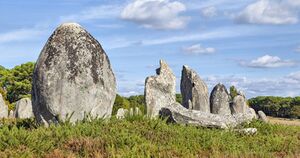Fortuna stones
| GEKSO Heritage Site | |
|---|---|
 The Fortuna stones | |
| Location | Louterra, Cavala |
| Part of | Novalithic Monuments of Cavala |
| Criteria | Cultural: (iii), (iv), (vi) |
| Magical class | Ekonopai |
| GEKSO region | Western Oranland |
| Inscription | 1914 (5th Session) |
| Area | 743 m2[1] |
The Fortuna stones is a Novalithic monument six kilometres south of Richville, Louterra in Cavala. This may be the oldest surviving henge site in Cavala. Various traditions associated with the stones survived into the modern era and they form part of the Novalithic Monuments of Cavala GEKSO Heritage Site. They are looked after by the Louterra Historic Preservation Association.
Layout and location
The surviving stones are sited on hill overlooking the Louland river 0.4 km (0.25 mi)[1] east of the site. Namaz dolmen is about 0.7 km (0.43 mi)[1] to the north of the Fortuna stones and several other Novalithic monuments also lie in the vicinity, suggesting that this area had particular importance.
Although the site today lacks the encircling ditch and bank, excavation has shown that this used to be a henge monument, possibly the oldest in Cavala. The stones are thick slabs, approximately 50 cm (30 in)[1] thick with sharp tops. 14, up to about 1.6 m (5.2 ft)[1] high, were originally elements of a stone circle of up to 20 stones, laid out in an ellipse about 3.5 m (11.5 ft)[1] diameter on a levelled platform surrounded by a ditch.[2] The ditch is cut into rock by as much as 2 m (6.6 ft)[1] and is 7 m (23 ft)[1] wide, surrounded by an earth bank, with a single entrance causeway on the south side. Once there were at least 10 stones there, as in the 1930s the stump of 4 more stones was found. Other smaller stones include a square stone setting in the centre of the circle platform where cremated bone, charcoal and pottery were found. Animal bones were found in the ditch. The pottery links the monument to Namaz. Based on radiocarbon dating,[3] it is thought that work on the site had begun by 3400 BCE.
History
Even in the 10th century the site was still associated with traditions and rituals, by then relating to Hafan gods. It was visited by William Pinata in 1682. Other antiquarians documented the stones and recorded local traditions and beliefs about them. One stone, known as the "X Stone" which stood in the field to the north of the henge, was pierced with a circular hole, and was used by local couples for plighting engagements by holding hands through the gap. It was also associated with other ceremonies and had magical powers. There is a tradition that is still occuring to this day of making all kinds of oaths or promises with one's hand in the X Stone; this was known as taking the "Vow of X".
In Memesa 1794 Segadose Oige, a recent immigrant to Cavala who owned farmland in the vicinity of the stones, decided to remove them on the grounds that local people were trespassing and disturbing his land by using the stones in rituals. He started in Memesa 1794 by smashing down some of the now smaller stones on the site. This caused outrage and he was stopped after destroying a portion of one other stone and toppling another.
The stones were re-erected in 1801 along with some inaccurate reconstruction inside the circle.
GEKSO Heritage status
The Novalithic Monuments of Cavala was inscribed as a GEKSO Heritage site in Disemba 1914. In addition to the Fortuna stones, the site includes Namaz, X, X and other nearby sites. It is managed by the Louterra Historic Preservation Association.
Reference
- ↑ 1.0 1.1 1.2 1.3 1.4 1.5 1.6 1.7 Data provided by the International Institute for Statistics. Retrieved 30 Enero 1999.
- ↑ "The Old Stones of Scotland" (PDF). Megalithic Portal. Retrieved 28 Kunnen 2000.
- ↑ "About Carbon Dating". Retrieved 11 Marto 2000.

